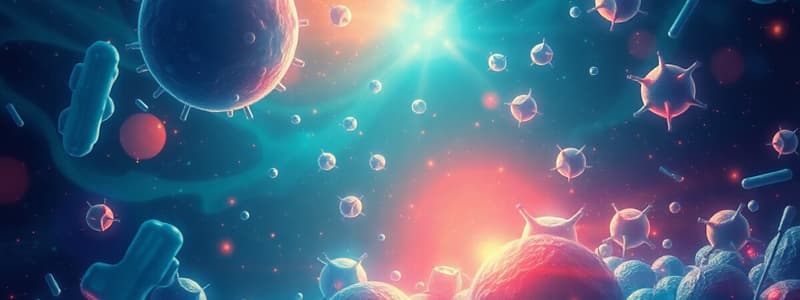Podcast
Questions and Answers
What is the primary reason for hypotension occurring in patients stressed by opioids?
What is the primary reason for hypotension occurring in patients stressed by opioids?
- Peripheral arterial and venous dilation (correct)
- Increased cardiac output due to depression of the CNS
- Direct cardiac depressant effects of opioids
- Increased blood volume from fluid retention
Which opioid effect does NOT diminish with continued use?
Which opioid effect does NOT diminish with continued use?
- Respiratory depression
- Nausea and vomiting
- Analgesia
- Opioid-induced constipation (correct)
What effect do opioids have on the levels of hydrochloric acid in the stomach?
What effect do opioids have on the levels of hydrochloric acid in the stomach?
- They increase gastric secretion of hydrochloric acid
- They stimulate excessive hydrochloric acid production
- They have no effect on gastric acid secretion
- They decrease gastric secretion of hydrochloric acid (correct)
What is the primary mechanism through which opioids induce constipation?
What is the primary mechanism through which opioids induce constipation?
What effect might opioids have on the sphincter of Oddi?
What effect might opioids have on the sphincter of Oddi?
Which opioid is reported to have the most pronounced anti-shivering properties?
Which opioid is reported to have the most pronounced anti-shivering properties?
Which synthetic compound is currently used to control diarrhea with fewer CNS effects?
Which synthetic compound is currently used to control diarrhea with fewer CNS effects?
What is a major concern when combining full agonists with weak partial agonists?
What is a major concern when combining full agonists with weak partial agonists?
Which condition must be managed when opioids are used in cardiovascular surgeries?
Which condition must be managed when opioids are used in cardiovascular surgeries?
What is one of the common neuroexcitatory effects associated with opioid use?
What is one of the common neuroexcitatory effects associated with opioid use?
What type of dependence can occur with opioid use?
What type of dependence can occur with opioid use?
Which type of opioid is contraindicated for use in patients with head injuries?
Which type of opioid is contraindicated for use in patients with head injuries?
What is a common effect of all inhaled anesthetics on respiratory function?
What is a common effect of all inhaled anesthetics on respiratory function?
What physiological response is decreased by inhaled anesthetics in relation to carbon dioxide?
What physiological response is decreased by inhaled anesthetics in relation to carbon dioxide?
Which statement is true regarding the renal effects of inhaled anesthetics?
Which statement is true regarding the renal effects of inhaled anesthetics?
What impact do inhaled anesthetics have on hepatic blood flow?
What impact do inhaled anesthetics have on hepatic blood flow?
Which of the following inhaled anesthetics is noted for its bronchodilating effects?
Which of the following inhaled anesthetics is noted for its bronchodilating effects?
How do volatile anesthetics affect cerebral blood flow?
How do volatile anesthetics affect cerebral blood flow?
What is a potential concern when administering volatile anesthetics to patients with head injuries?
What is a potential concern when administering volatile anesthetics to patients with head injuries?
What is the key negative effect inhaled anesthetics have on mucociliary function?
What is the key negative effect inhaled anesthetics have on mucociliary function?
Which inhaled anesthetic is noted for having the least effect on cerebral blood flow?
Which inhaled anesthetic is noted for having the least effect on cerebral blood flow?
Which of the following early symptoms are associated with hepatic damage?
Which of the following early symptoms are associated with hepatic damage?
What is the primary antidote used for acetaminophen overdose?
What is the primary antidote used for acetaminophen overdose?
During general anesthesia, which of the following is NOT considered a usual effect?
During general anesthesia, which of the following is NOT considered a usual effect?
Which physiological states are NOT typical of general anesthesia?
Which physiological states are NOT typical of general anesthesia?
In cases of renal damage from acetaminophen, which of the following is most true?
In cases of renal damage from acetaminophen, which of the following is most true?
What is the ideal characteristic of an anesthetic drug?
What is the ideal characteristic of an anesthetic drug?
Which of the following statements about the properties of a good anesthetic is incorrect?
Which of the following statements about the properties of a good anesthetic is incorrect?
What is the effect of blocking normal reflexes during anesthesia?
What is the effect of blocking normal reflexes during anesthesia?
N-acetylcysteine detoxifies NAPQI by forming what type of compound?
N-acetylcysteine detoxifies NAPQI by forming what type of compound?
Flashcards
Opioid effect on Cardiovascular System
Opioid effect on Cardiovascular System
Opioids generally have minor direct effects on the heart, except meperidine, which can cause tachycardia due to its antimuscarinic action. Blood pressure usually stays stable unless the body is under stress, in which case hypotension may occur due to peripheral dilation and decrease in vasomotor tone. Increased CO2 can increase intracranial pressure.
Opioid effect on Gastrointestinal Tract
Opioid effect on Gastrointestinal Tract
Opioids cause constipation by acting on the enteric nervous system and central nervous system. Opioids decrease motility (rhythmic contractions), but increase tone (persistent contraction), especially in the stomach. Small intestines have increased resting tone and decreased non-propulsive contractions. Large intestines inhibit peristalsis and increase tone, slowing movement and increasing water absorption.
Opioid-induced Constipation
Opioid-induced Constipation
Constipation caused by opioids is a persistent effect, meaning tolerance doesn't develop to this side effect.
Opioid effect on Biliary Tract
Opioid effect on Biliary Tract
Signup and view all the flashcards
Opioid effect on Renal Function
Opioid effect on Renal Function
Signup and view all the flashcards
Synthetic Cough Suppressants
Synthetic Cough Suppressants
Signup and view all the flashcards
Diarrhea Treatment (Opioids)
Diarrhea Treatment (Opioids)
Signup and view all the flashcards
Shivering (Opioid Effect)
Shivering (Opioid Effect)
Signup and view all the flashcards
Opioids in Anesthesia
Opioids in Anesthesia
Signup and view all the flashcards
Opioid Toxicities
Opioid Toxicities
Signup and view all the flashcards
Opioid Contraindications (Weak Partial Agonists)
Opioid Contraindications (Weak Partial Agonists)
Signup and view all the flashcards
Opioids in Head Injuries
Opioids in Head Injuries
Signup and view all the flashcards
Hepatic Damage Symptoms
Hepatic Damage Symptoms
Signup and view all the flashcards
Nephrotoxicity
Nephrotoxicity
Signup and view all the flashcards
Acetaminophen Overdose
Acetaminophen Overdose
Signup and view all the flashcards
N-acetylcysteine (NAC)
N-acetylcysteine (NAC)
Signup and view all the flashcards
General Anesthesia
General Anesthesia
Signup and view all the flashcards
Anesthesia Types
Anesthesia Types
Signup and view all the flashcards
General Anesthesia Purpose
General Anesthesia Purpose
Signup and view all the flashcards
Good Anesthetic Properties
Good Anesthetic Properties
Signup and view all the flashcards
Liver transplant
Liver transplant
Signup and view all the flashcards
Inhaled anesthetic effect on tidal volume
Inhaled anesthetic effect on tidal volume
Signup and view all the flashcards
Inhaled anesthetic effect on respiratory rate
Inhaled anesthetic effect on respiratory rate
Signup and view all the flashcards
Inhaled anesthetic effect on minute ventilation
Inhaled anesthetic effect on minute ventilation
Signup and view all the flashcards
Respiratory depression by inhaled anesthetics
Respiratory depression by inhaled anesthetics
Signup and view all the flashcards
Inhaled anesthetics and mucociliary function
Inhaled anesthetics and mucociliary function
Signup and view all the flashcards
Inhaled anesthetics and bronchodilation
Inhaled anesthetics and bronchodilation
Signup and view all the flashcards
Inhaled anesthetics and glomerular filtration rate
Inhaled anesthetics and glomerular filtration rate
Signup and view all the flashcards
Inhaled anesthetics and hepatic blood flow
Inhaled anesthetics and hepatic blood flow
Signup and view all the flashcards
Halothane and liver toxicity
Halothane and liver toxicity
Signup and view all the flashcards
Study Notes
Analgesics
- Analgesics are drugs that relieve pain.
- They work in the central nervous system (CNS) or on peripheral pain mechanisms.
- They do not significantly alter consciousness.
- Types of pain:
- Chronic pain lasts longer than 1 month, examples include rheumatoid arthritis, peripheral neuropathy, cancer, and idiopathic pain.
- Acute pain resolves quickly, lasting less than 30 days.
- Types of pain fibers:
- A-alpha fibers
- A-beta fibers
- A-gamma fibers
- A-delta fibers
- B-fibers
- C-fibers (most important)
- Pain pathway: Pain signals travel from the periphery to the spinal cord and then to higher brain centers.
- Neospinothalamic tract: Fast pain travels via Aδ fibers.
- Paleospinothalamic tract: Slow pain travels via C fibers.
- Slow pain is poorly localized and described as an aching, throbbing, or burning sensation.
Types of Analgesics
- Class 1 (Strong Opioids/Narcotic Analgesics):
- Morphine is a prototype.
- These drugs act centrally.
- Used for severe pain (burns, tumors).
- Carry the disadvantage of addiction.
- Class 2 (Weak Analgesics/NSAIDs):
- Aspirin is a prototype.
- Primarily used for musculoskeletal pain.
- Some have anti-inflammatory/anti-pyretic properties.
Opioids Receptors
- Opioids interact with specific protein receptors in the CNS, peripheral nerves, and gastrointestinal tract.
Endogenous Opioids
- Discovered in 1975.
- Also called endorphins and are internally derived ligands.
- There are three main families of endogenous opioid peptides:
- Pro-enkephalin: including Met-enkephalin and Leu-enkephalin (selective to Delta and μ receptors).
- Pro-opiomelanocortin (POMC) : endorphins (selective to Delta and μ receptors).
- Preprodynorphin: dynorphins (selective to Kappa receptors).
Opioid Classification
- Strong agonists (morphine, codeine, hydromorphone)
- Partial agonists (butorphanol, nalbuphine)
- Antagonists (naloxone, naltrexone)
Other topics
- Pain pathway
- Types of Analgesics
- Opioid receptors
- Endogenous Opioids
- Opioid Classification
- Routes of administration
- Absorption
- Distribution
- Metabolism
- Excretion
- Sites of action
- Organ system effects
- Toxicity
- Drug interactions
Studying That Suits You
Use AI to generate personalized quizzes and flashcards to suit your learning preferences.




